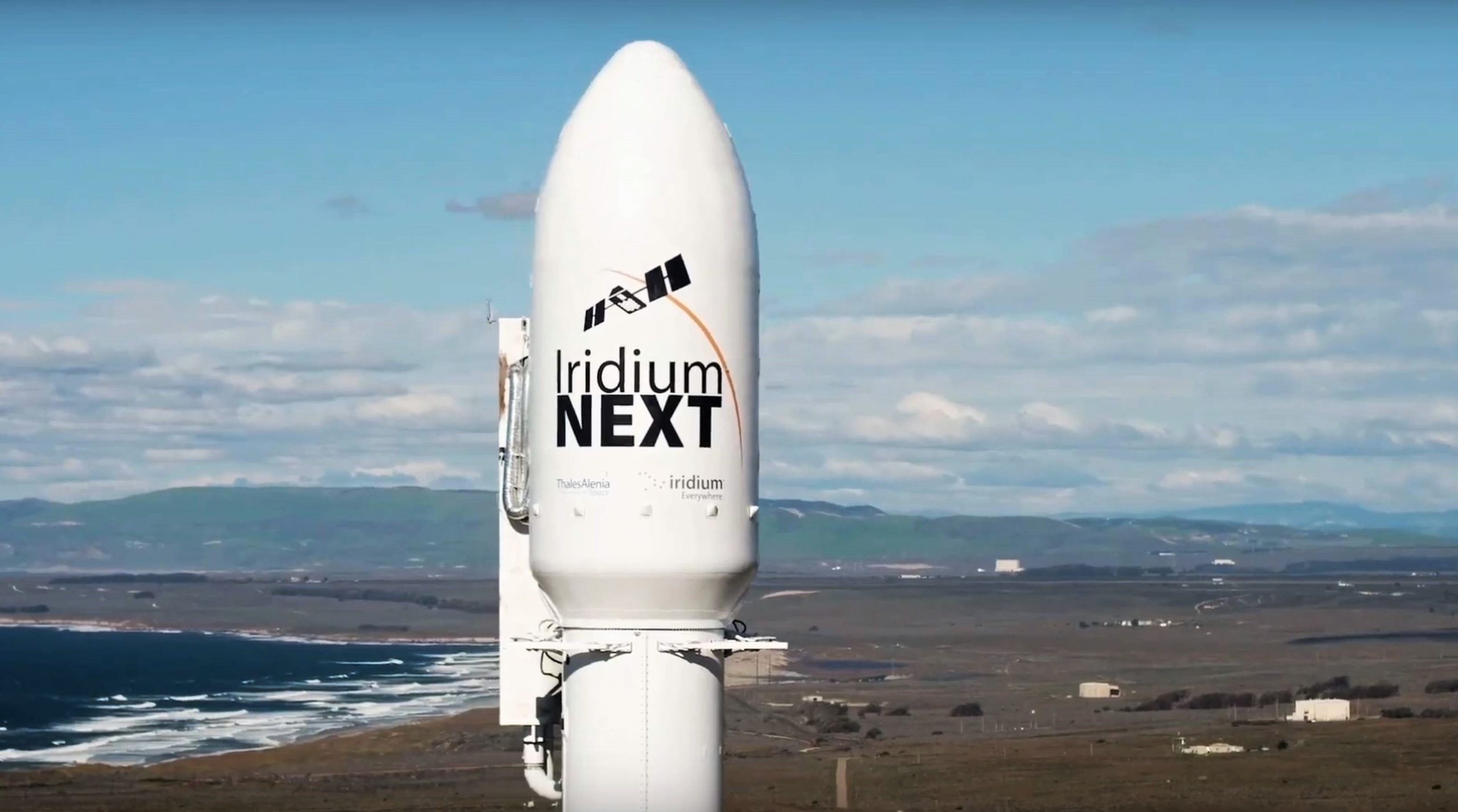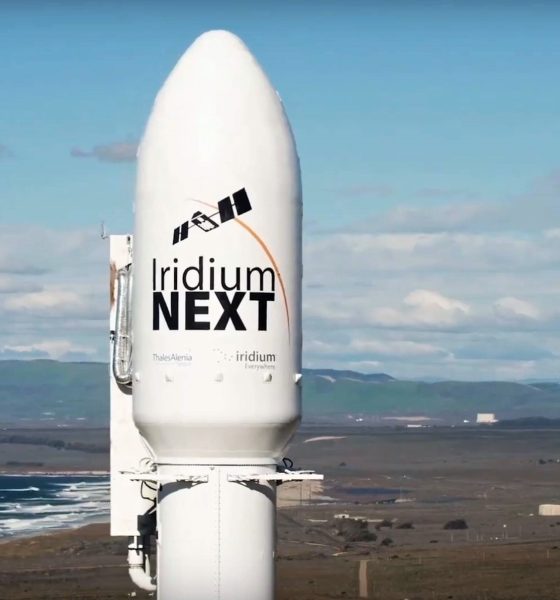

News
SpaceX to launch ninth batch of Iridium NEXT satellites
Iridium Communications has chosen SpaceX to launch one last batch of its NEXT communications satellites, rounding out the constellation with up to five more on-orbit spares.
The company says that SpaceX’s Falcon 9 rocket will launch those satellites as part of a rideshare mission that is scheduled to lift off from California’s Vandenberg Space Force Base (VSFB) no earlier than mid-2023.
Iridium and SpaceX have had a close relationship for as long as Falcon 9 has been flying. In 2010, days after Falcon 9’s first successful launch, the company – led by CEO Matt Desch – awarded SpaceX a head-turning contract worth almost $500 million for the launch of the entire Iridium NEXT constellation. SpaceX kicked off Iridium NEXT launches in early 2017, returning to flight after a Falcon 9 rocket exploded on the launch pad just four months prior.
Less than two years later, SpaceX had completed eight Falcon 9 launches for Iridum and successfully deployed the full 75-satellite NEXT constellation (up from initial plans for 72 satellites) in polar orbit. Now, after what will be a four-and-a-half-year hiatus of joint activities, Iridium wants SpaceX to launch up to five of the six remaining NEXT spares, meaning that Falcon 9 will likely be responsible for launching all but one satellite of the constellation.
When SpaceX completed its eighth and (at the time) final Iridium launch in January 2019, the communications provider was left with nine NEXT satellite spares in orbit and six spares on the ground – all ready to take over (or be launched) in the event of an anomaly. Built by Thales Alenia Space, those satellites – built and launched for approximately $2.9 billion – have proven exceptionally reliable. Close to six years after the first launch, none of the 75 satellites currently in orbit have failed.
Iridium isn’t launching the six remaining ground spares because it needs them, in other words. On top of nixing the cost of storing satellites for years, Iridium’s CEO says that launching those spares now will “make [the NEXT] network even more resilient.” Prior to the September 8th announcement, Iridium’s Q2 2022 earnings report revealed a $35 million contract to launch five of the six remaining NEXT spares – almost certainly referring to its ninth SpaceX launch. Accounting for inflation, Iridium paid SpaceX approximately $8.9 million in 2022 dollars for each of the first 75 NEXT satellites it launched. For its ninth SpaceX launch, Iridium will pay $7 million – 21% less.
In 2020, Iridium signed a nonbinding agreement with startup Relativity Space to potentially launch all six spares on its 3D-printed Terran 1 rocket. Two years later, it appears that Iridium has mostly changed its mind, and no longer wants to worry about launching its NEXT spares “on an as-needed basis.” With a list price of $12 million, Terran 1 would only be able to launch one 860-kilogram (1900 lb) Iridium NEXT satellite at a time, translating to at least $72 million for all six. As is common for new launch vehicles, Terran 1 has also run into many delays, although Relativity says it could debut as soon as October 2022. It’s possible that Terran 1 could still launch the last Iridium NEXT ground spare, but statements published on Twitter by CEO Matt Desch do not inspire confidence.
Ultimately, Iridium seems to have elected to launch most or all of the remaining spares at once, simultaneously saving tens of millions of dollars and adding additional resiliency to its communications services.

News
Tesla FSD fleet is nearing 7 billion total miles, including 2.5 billion city miles
As can be seen on Tesla’s official FSD webpage, vehicles equipped with the system have now navigated over 6.99 billion miles.

Tesla’s Full Self-Driving (Supervised) fleet is closing in on almost 7 billion total miles driven, as per data posted by the company on its official FSD webpage.
These figures hint at the massive scale of data fueling Tesla’s rapid FSD improvements, which have been quite notable as of late.
FSD mileage milestones
As can be seen on Tesla’s official FSD webpage, vehicles equipped with the system have now navigated over 6.99 billion miles. Tesla owner and avid FSD tester Whole Mars Catalog also shared a screenshot indicating that from the nearly 7 billion miles traveled by the FSD fleet, more than 2.5 billion miles were driven inside cities.
City miles are particularly valuable for complex urban scenarios like unprotected turns, pedestrian interactions, and traffic lights. This is also the difference-maker for FSD, as only complex solutions, such as Waymo’s self-driving taxis, operate similarly on inner-city streets. And even then, incidents such as the San Francisco blackouts have proven challenging for sensor-rich vehicles like Waymos.
Tesla’s data edge
Tesla has a number of advantages in the autonomous vehicle sector, one of which is the size of its fleet and the number of vehicles training FSD on real-world roads. Tesla’s nearly 7 billion FSD miles then allow the company to roll out updates that make its vehicles behave like they are being driven by experienced drivers, even if they are operating on their own.
So notable are Tesla’s improvements to FSD that NVIDIA Director of Robotics Jim Fan, after experiencing FSD v14, noted that the system is the first AI that passes what he described as a “Physical Turing Test.”
“Despite knowing exactly how robot learning works, I still find it magical watching the steering wheel turn by itself. First it feels surreal, next it becomes routine. Then, like the smartphone, taking it away actively hurts. This is how humanity gets rewired and glued to god-like technologies,” Fan wrote in a post on X.
News
Tesla starts showing how FSD will change lives in Europe
Local officials tested the system on narrow country roads and were impressed by FSD’s smooth, human-like driving, with some calling the service a game-changer for everyday life in areas that are far from urban centers.

Tesla has launched Europe’s first public shuttle service using Full Self-Driving (Supervised) in the rural Eifelkreis Bitburg-Prüm region of Germany, demonstrating how the technology can restore independence and mobility for people who struggle with limited transport options.
Local officials tested the system on narrow country roads and were impressed by FSD’s smooth, human-like driving, with some calling the service a game-changer for everyday life in areas that are far from urban centers.
Officials see real impact on rural residents
Arzfeld Mayor Johannes Kuhl and District Administrator Andreas Kruppert personally tested the Tesla shuttle service. This allowed them to see just how well FSD navigated winding lanes and rural roads confidently. Kruppert said, “Autonomous driving sounds like science fiction to many, but we simply see here that it works totally well in rural regions too.” Kuhl, for his part, also noted that FSD “feels like a very experienced driver.”
The pilot complements the area’s “Citizen Bus” program, which provides on-demand rides for elderly residents who can no longer drive themselves. Tesla Europe shared a video of a demonstration of the service, highlighting how FSD gives people their freedom back, even in places where public transport is not as prevalent.
What the Ministry for Economic Affairs and Transport says
Rhineland-Palatinate’s Minister Daniela Schmitt supported the project, praising the collaboration that made this “first of its kind in Europe” possible. As per the ministry, the rural rollout for the service shows FSD’s potential beyond major cities, and it delivers tangible benefits like grocery runs, doctor visits, and social connections for isolated residents.
“Reliable and flexible mobility is especially vital in rural areas. With the launch of a shuttle service using self-driving vehicles (FSD supervised) by Tesla in the Eifelkreis Bitburg-Prüm, an innovative pilot project is now getting underway that complements local community bus services. It is the first project of its kind in Europe.
“The result is a real gain for rural mobility: greater accessibility, more flexibility and tangible benefits for everyday life. A strong signal for innovation, cooperation and future-oriented mobility beyond urban centers,” the ministry wrote in a LinkedIn post.
News
Tesla China quietly posts Robotaxi-related job listing
Tesla China is currently seeking a Low Voltage Electrical Engineer to work on circuit board design for the company’s autonomous vehicles.

Tesla has posted a new job listing in Shanghai explicitly tied to its Robotaxi program, fueling speculation that the company is preparing to launch its dedicated autonomous ride-hailing service in China.
As noted in the listing, Tesla China is currently seeking a Low Voltage Electrical Engineer to work on circuit board design for the company’s autonomous vehicles.
Robotaxi-specific role
The listing, which was shared on social media platform X by industry watcher @tslaming, suggested that Tesla China is looking to fill the role urgently. The job listing itself specifically mentions that the person hired for the role will be working on the Low Voltage Hardware team, which would design the circuit boards that would serve as the nervous system of the Robotaxi.
Key tasks for the role, as indicated in the job listing, include collaboration with PCB layout, firmware, mechanical, program management, and validation teams, among other responsibilities. The role is based in Shanghai.
China Robotaxi launch
China represents a massive potential market for robotaxis, with its dense urban centers and supportive policies in select cities. Tesla has limited permission to roll out FSD in the country, though despite this, its vehicles have been hailed as among the best in the market when it comes to autonomous features. So far, at least, it appears that China supports Tesla’s FSD and Robotaxi rollout.
This was hinted at in November, when Tesla brought the Cybercab to the 8th China International Import Expo (CIIE) in Shanghai, marking the first time that the autonomous two-seater was brought to the Asia-Pacific region. The vehicle, despite not having a release date in China, received a significant amount of interest among the event’s attendees.








